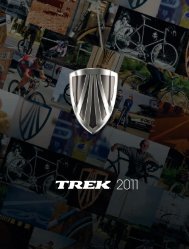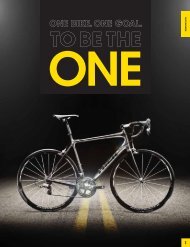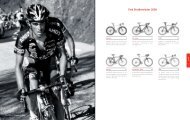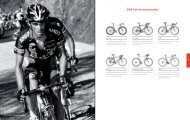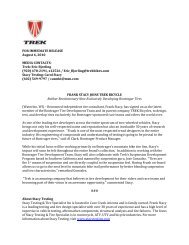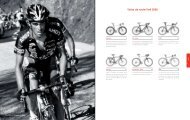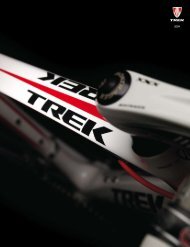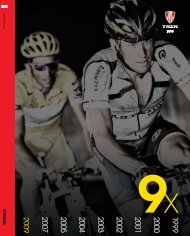Airfoil Development for the Trek Speed Concept ... - Slowtwitch.com
Airfoil Development for the Trek Speed Concept ... - Slowtwitch.com
Airfoil Development for the Trek Speed Concept ... - Slowtwitch.com
Create successful ePaper yourself
Turn your PDF publications into a flip-book with our unique Google optimized e-Paper software.
As a result, <strong>the</strong> aerodynamic rules governing cycling are most similar to those governing sailing. In sailing it is possible to obtain<br />
<strong>for</strong>ward thrust, even when traveling nearly directly into <strong>the</strong> wind. Like <strong>the</strong> centerboard of a sailboat, <strong>the</strong> wheels of a bicycle redirect<br />
<strong>the</strong> lift <strong>for</strong>ce in <strong>the</strong> wind-axes into a thrust <strong>for</strong>ce in <strong>the</strong> direction of bicycle (or boat) motion. However, <strong>the</strong> drag <strong>for</strong>ce in <strong>the</strong> wind-axes<br />
still contributes to a drag <strong>for</strong>ce in <strong>the</strong> bicycle direction. For traditional bicycle airfoils, <strong>the</strong> wind-axes lift <strong>for</strong>ce is much smaller than<br />
<strong>the</strong> wind-axes drag <strong>for</strong>ce, resulting in a net drag <strong>for</strong>ce in <strong>the</strong> bicycle direction. In contrast, <strong>the</strong> KVF has an extremely high lift to drag<br />
ratio in <strong>the</strong> wind-axes, allowing it to achieve a net thrust in <strong>the</strong> bicycle direction, just like a sailboat. This result is somewhat counterintuitive<br />
and unprecedented <strong>for</strong> bicycle airfoils, so an illustration is provided in <strong>the</strong> figure below.<br />
Figure 26: Diagram illustrating a case where<br />
negative drag occurs (in <strong>the</strong> bicycle-axes).<br />
It is also possible to obtain wind-axis lift by simply creating more side (sail-like) surface on <strong>the</strong> bicycle system. However, this added<br />
surface <strong>com</strong>es at <strong>the</strong> penalty of weight. Due to cross-wind stability concerns, side surfaces must be carefully designed into a bicycle<br />
system. The most stable location <strong>for</strong> such surface is low and rearward, making <strong>the</strong> rear disc wheel a popular choice.<br />
3 Misaligned <strong>Airfoil</strong>s<br />
<strong>Trek</strong> has received questions about <strong>the</strong> effect of misaligning an airfoil from <strong>the</strong> bike-axis, such as a handlebar which is not perfectly<br />
horizontal, whe<strong>the</strong>r intentionally or not. A well-designed airfoil will have very low <strong>for</strong>ce (drag) in <strong>the</strong> major chord direction and, as a<br />
natural result, very high <strong>for</strong>ce (lift) in <strong>the</strong> minor chord direction. For maximum efficiency, <strong>the</strong> direction of bicycle motion should align<br />
with <strong>the</strong> direction of minimum <strong>for</strong>ce (and <strong>the</strong>re<strong>for</strong>e with <strong>the</strong> airfoil).<br />
Although <strong>the</strong> wind tunnel measures <strong>the</strong> lift and drag <strong>for</strong>ces in <strong>the</strong> airfoil-axes, <strong>the</strong>se <strong>for</strong>ces are easily trans<strong>for</strong>med into <strong>the</strong> wind-axis,<br />
which now be<strong>com</strong>es <strong>the</strong> bike-axis. This trans<strong>for</strong>mation, along with an adjustment to ensure equivalent wind speed <strong>for</strong> each data<br />
point, allows a study of airfoil yaw angles to be converted into a study of airfoil misalignment angles. In o<strong>the</strong>r words, think of <strong>the</strong><br />
direction of bicycle motion as always facing straight into <strong>the</strong> wind in <strong>the</strong> wind tunnel. Then, as <strong>the</strong> airfoil is rotated, this rotation can<br />
be thought of as misalignment from <strong>the</strong> bicycle-axis instead of yaw.<br />
22




